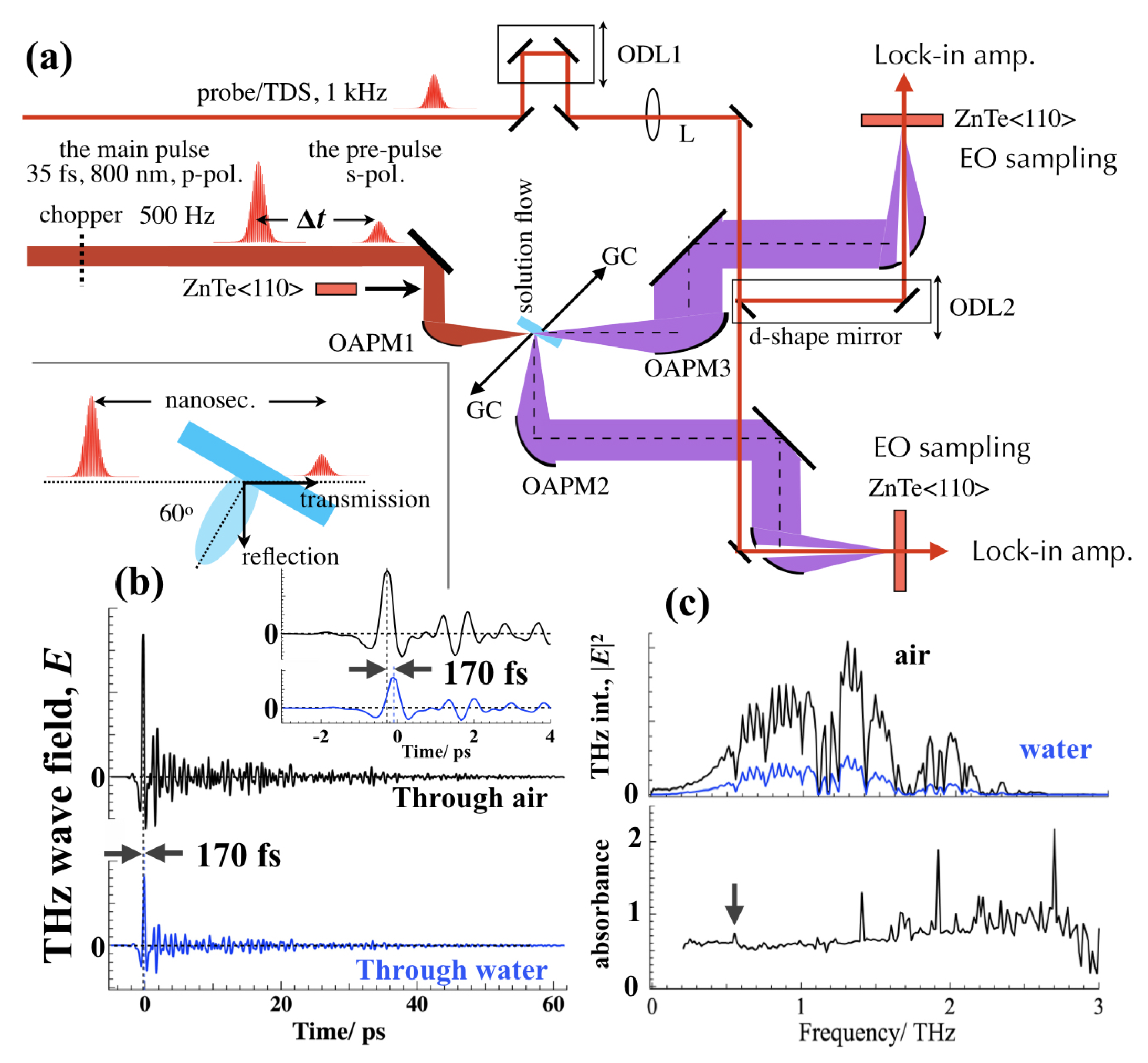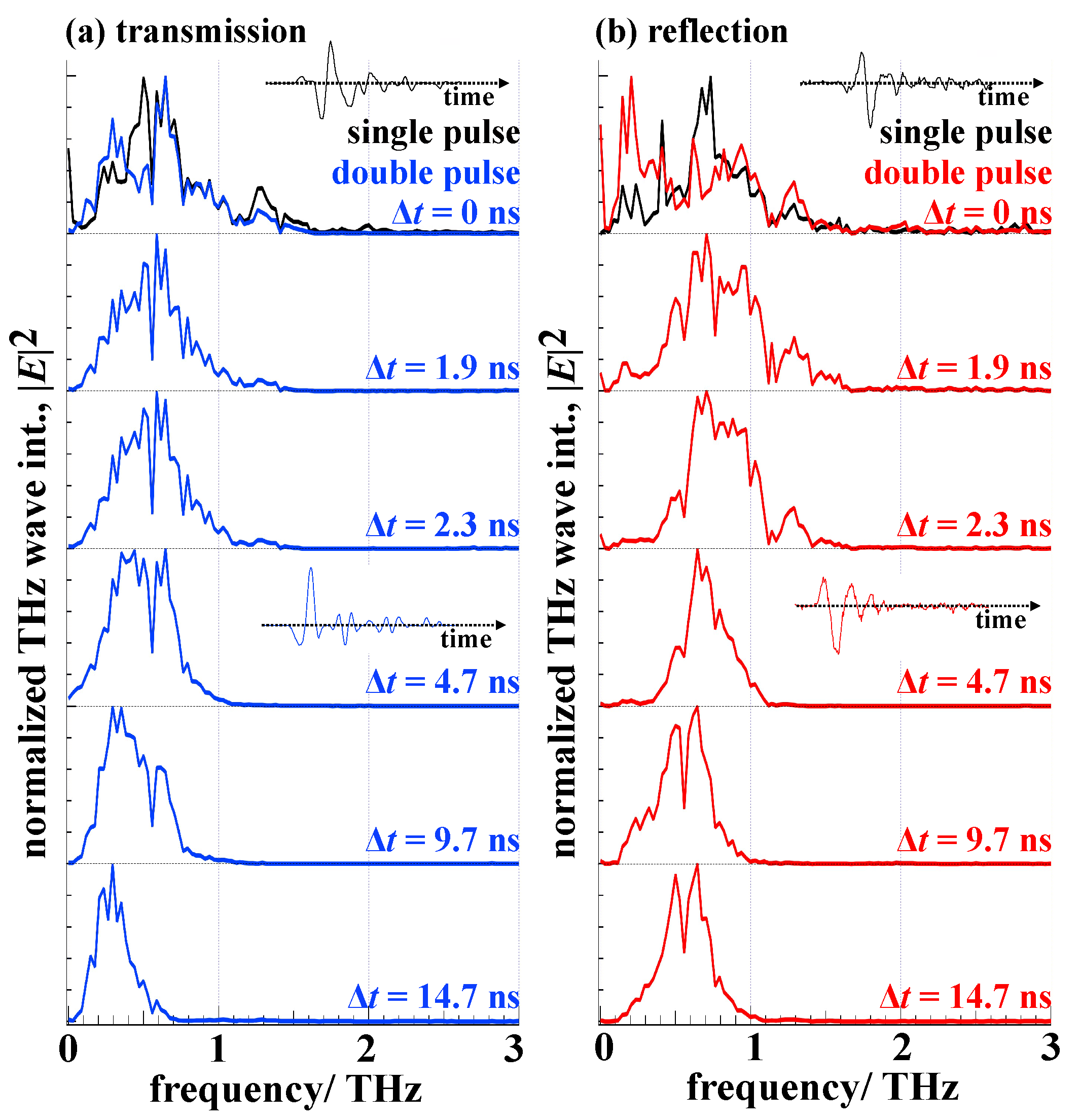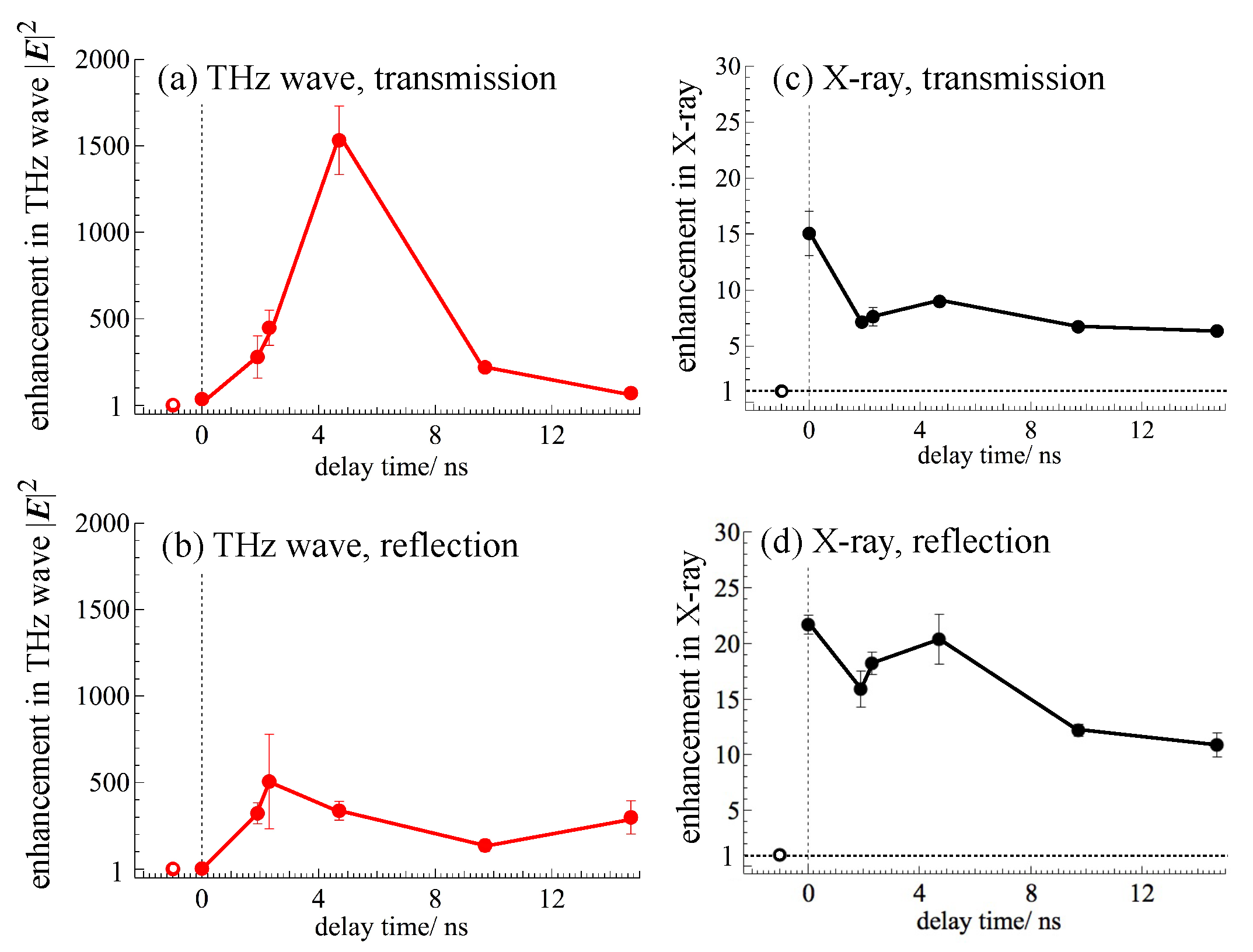Giant Enhancement of THz Wave Emission under Double-Pulse Excitation of Thin Water Flow
Abstract
1. Introduction
2. Experimental Setup
2.1. Double-Pulse Excitation of Water Flow
2.2. THz Wave Time-Domain Spectroscopy in the Transmission/Reflection Directions
2.3. X-ray Detection
3. Results
3.1. THz Spectroscopy
3.2. THz Enhancement
4. Discussion
4.1. Effects of the Pre-Pulse Irradiation
4.2. Spectral Peak Shift
4.3. Giant Enhancement in THz Emission
5. Conclusions and Outlook
Author Contributions
Funding
Conflicts of Interest
References
- Mittleman, D.M. Perspective: Terahertz science and technology. J. Appl. Phys. 2017, 122, 230901. [Google Scholar] [CrossRef]
- Fattinger, C.; Grischkowsky, D. Terahertz beams. Appl. Phys. Lett. 1989, 54, 490–492. [Google Scholar] [CrossRef]
- Mittleman, D.M. Twenty years of terahertz imaging. Opt. Express 2018, 26, 9417–9431. [Google Scholar] [CrossRef]
- Sahoo, A.; Yang, C.S.; Yen, C.L.; Lin, H.C.; Wang, Y.J.; Lin, Y.H.; Wada, O.; Pan, C.L. Twisted nematic liquid-crystal-based terahertz phase shifter using pristine PEDOT: PSS transparent conducting electrodes. Appl. Sci. 2019, 9, 761. [Google Scholar] [CrossRef]
- Li, R.; D’Agostino, C.; McGregor, J.; Mantle, M.D.; Zeitler, J.A.; Gladden, L.F. Mesoscopic structuring and dynamics of alcohol/water solutions probed by terahertz time-domain spectroscopy and pulsed field gradient nuclear magnetic resonance. J. Phys. Chem. B 2014, 118, 10156–10166. [Google Scholar] [CrossRef]
- Mou, S.; Rubano, A.; Paparo, D. Terahertz hyper-Raman time-domain spectroscopy of gallium selenide and its application in terahertz detection. Appl. Phys. Lett. 2019, 115, 211105. [Google Scholar] [CrossRef]
- Hindle, F.; Bocquet, R.; Pienkina, A.; Cuisset, A.; Mouret, G. Terahertz gas phase spectroscopy using a high-finesse Fabry-Pérot cavity. Optica 2019, 6, 1449–1454. [Google Scholar] [CrossRef]
- Chevalier, P.; Amirzhan, A.; Wang, F.; Piccardo, M.; Johnson, S.G.; Capasso, F.; Everitt, H.O. Widely tunable compact terahertz gas lasers. Science 2019, 366, 856–860. [Google Scholar] [CrossRef]
- Sun, C.K.; Chen, H.Y.; Tseng, T.F.; You, B.; Wei, M.L.; Lu, J.Y.; Chang, Y.L.; Tseng, W.L.; Wang, T.D. High sensitivity of T-ray for thrombus sensing. Sci. Rep. 2018, 8, 3948. [Google Scholar] [CrossRef]
- Yang, P.; Xiao, Y.; Xiao, M.; Li, S. 6G Wireless communications: Vision and potential techniques. IEEE Net. 2019, 33, 70–75. [Google Scholar] [CrossRef]
- Cocker, T.L.; Jelic, V.; Gupta, M.; Molesky, S.J.; Burgess, J.A.J.; Reyes, G.D.L.; Titova, L.V.; Tsui, Y.Y.; Freeman, M.R.; Hegmann, F.A. An ultrafast terahertz scanning tunnelling microscope. Nat. Photon. 2013, 7, 620–625. [Google Scholar] [CrossRef]
- Klarskov, P.; Kim, H.; Colvin, V.L.; Mittleman, D.M. Nanoscale laser terahertz emission microscopy. ACS Photon. 2017, 4, 2676–2680. [Google Scholar] [CrossRef]
- Mastel, S.; Lundeberg, M.B.; Alonso-González, P.; Gao, Y.; Watanabe, K.; Taniguchi, T.; Hone, J.; Koppens, F.H.L.; Nikitin, A.Y.; Hillenbrand, R. Terahertz nanofocusing with cantilevered terahertz-resonant antenna tips. Nano Lett. 2017, 17, 6526–6533. [Google Scholar] [CrossRef]
- Wilke, I.; Sengupta, S. Nonlinear optical techniques for terahertz pulse generation and detection—Optical rectification and electrooptic sampling. In Terahertz Spectroscopy: Principles and Applications, 1st ed.; Dexheimer, S.L., Ed.; CRC Press: Boca Raton, FL, USA, 2007; Chapter 2; pp. 41–72. [Google Scholar]
- Hamster, H.; Sullivan, A.; Gordon, S.; Falcone, R.W. Short-pulse terahertz radiation from high-intensity-laser-produced plasmas. Phys. Rev. E 1994, 49, 671–677. [Google Scholar] [CrossRef]
- Cook, D.J.; Hochstrasser, R.M. Intense terahertz pulses by four-wave rectification in air. Opt. Lett. 2000, 25, 1210–1212. [Google Scholar] [CrossRef]
- Andreeva, V.A.; Kosareva, O.G.; Panov, N.A.; Shipilo, D.E.; Solyankin, P.M.; Esaulkov, M.N.; González de Alaiza Martínez, P.; Shkurinov, A.P.; Makarov, V.A.; Bergé, L.; et al. Ultrabroad terahertz spectrum generation from an air-based filament plasma. Phys. Rev. Lett. 2016, 116, 063902. [Google Scholar] [CrossRef]
- Chen, Y.; Yamaguchi, M.; Wang, M.; Zhang, X.C. Terahertz pulse generation from noble gases. Appl. Phys. Lett. 2007, 91, 251116. [Google Scholar] [CrossRef]
- Mori, K.; Hashida, M.; Nagashima, T.; Li, D.; Teramoto, K.; Nakamiya, Y.; Inoue, S.; Sakabe, S. Increased energy of THz waves from a cluster plasma by optimizing laser pulse duration. AIP Adv. 2019, 9, 015134. [Google Scholar] [CrossRef]
- Zhang, Z.; Panov, N.; Andreeva, V.; Zhang, Z.; Slepkov, A.; Shipilo, D.; Thomson, M.D.; Wang, T.J.; Babushkin, I.; Demircan, A.; et al. Optimum chirp for efficient terahertz generation from two-color femtosecond pulses in air. Appl. Phys. Lett. 2018, 113, 241103. [Google Scholar] [CrossRef]
- Kress, M.; Löffler, T.; Eden, S.; Thomson, M.; Roskos, H.G. Terahertz-pulse generation by photoionization of air with laser pulses composed of both fundamental and second-harmonic waves. Opt. Lett. 2004, 29, 1120–1122. [Google Scholar] [CrossRef]
- Zhong, H.; Karpowicz, N.; Zhang, X.C. Terahertz emission profile from laser-induced air plasma. Appl. Phys. Lett. 2006, 88, 261103. [Google Scholar] [CrossRef]
- Babushkin, I.; Kuehn, W.; Köhler, C.; Skupin, S.; Bergé, L.; Reimann, K.; Woerner, M.; Herrmann, J.; Elsaesser, T. Ultrafast spatiotemporal dynamics of terahertz generation by ionizing two-color femtosecond pulses in gases. Phys. Rev. Lett. 2010, 105, 053903. [Google Scholar] [CrossRef] [PubMed]
- Hah, J.; Jiang, W.; He, Z.H.; Nees, J.A.; Hou, B.; Thomas, A.G.R.; Krushelnick, K. Enhancement of THz generation by feedback—Optimized wavefront manipulation. Opt. Express 2017, 25, 17271–17279. [Google Scholar] [CrossRef] [PubMed]
- Tcypkin, A.N.; Ponomareva, E.A.; Putilin, S.E.; Smirnov, S.V.; Shtumpf, S.A.; Melnik, M.V.; E, Y.; Kozlov, S.A.; Zhang, X.C. Flat liquid jet as a highly efficient source of terahertz radiation. Opt. Express 2019, 27, 15485–15494. [Google Scholar] [CrossRef]
- Tcypkin, A.N.; Melnik, M.V.; Zhukova, M.O.; Vorontsova, I.O.; Putilin, S.E.; Kozlov, S.A.; Zhang, X.C. High kerr nonlinearity of water in THz spectral range. Opt. Express 2019, 27, 10419–10425. [Google Scholar] [CrossRef]
- Qi, J.; Yiwen, E.; Williams, K.; Dai, J.; Zhang, X.-C. Observation of broadband terahertz wave generation from liquid water. Appl. Phys. Lett. 2017, 111, 071103. [Google Scholar]
- E, Y.; Jin, Q.; Tcypkin, A.; Zhang, X.C. Terahertz wave generation from liquid water films via laser-induced breakdown. Appl. Phys. Lett. 2018, 113, 181103. [Google Scholar] [CrossRef]
- Jin, Q.; Dai, J.; E, Y.; Zhang, X.C. Terahertz wave emission from a liquid water film under the excitation of asymmetric optical fields. Appl. Phys. Lett. 2018, 113, 261101. [Google Scholar] [CrossRef]
- Zhang, L.L.; Wang, W.M.; Wu, T.; Feng, S.J.; Kang, K.; Zhang, C.L.; Zhang, Y.; Li, Y.T.; Sheng, Z.M.; Zhang, X.C. Strong terahertz radiation from a liquid-water line. Phys. Rev. Appl. 2019, 12, 014005. [Google Scholar] [CrossRef]
- Dey, I.; Jana, K.; Fedorov, V.Y.; Koulouklidis, A.D.; Mondal, A.; Shaikh, M.; Sarkar, D.; Lad, A.D.; Tzortzakis, S.; Couairon, A.; et al. Highly efficient broadband terahertz generation from ultrashort laser filamentation in liquids. Nat. Commun. 2017, 8, 1184. [Google Scholar] [CrossRef]
- Huang, H.H.; Nagashima, T.; Hsu, W.H.; Juodkazis, S.; Hatanaka, K. Dual THz wave and X-ray generation from a water film under femtosecond laser excitation. Nanomaterials 2018, 8, 523. [Google Scholar] [CrossRef] [PubMed]
- Hatanaka, K.; Ono, H.; Fukumura, H. X-ray pulse emission from cesium chloride aqueous solutions when irradiated by double-pulsed femtosecond laser pulses. Appl. Phys. Lett. 2008, 93, 064103. [Google Scholar] [CrossRef]
- Hatanaka, K.; Miura, T.; Fukumura, H. Ultrafast x-ray pulse generation by focusing femtosecond infrared laser pulses onto aqueous solutions of alkali metal chloride. Appl. Phys. Lett. 2002, 80, 3925–3927. [Google Scholar] [CrossRef]
- Masim, F.C.P.; Porta, M.; Hsu, W.H.; Nguyen, M.T.; Yonezawa, T.; Balčytis, A.; Juodkazis, S.; Hatanaka, K. Au nanoplasma as efficient hard X-ray emission source. ACS Photon. 2016, 3, 2184–2190. [Google Scholar] [CrossRef]
- Hsu, W.H.; Masim, F.C.P.; Balčytis, A.; Huang, H.H.; Yonezawa, T.; Kuchmizhak, A.A.; Juodkazis, S.; Hatanaka, K. Enhancement of X-ray emission from nanocolloidal gold suspensions under double-pulse excitation. Beilstein J. Nanotechnol. 2018, 9, 2609–2617. [Google Scholar] [CrossRef]
- Mori, K.; Hashida, M.; Nagashima, T.; Li, D.; Teramoto, K.; Nakamiya, Y.; Inoue, S.; Sakabe, S. Directional linearly polarized terahertz emission from argon clusters irradiated by noncollinear double-pulse beams. Appl. Phys. Lett. 2017, 111, 241107. [Google Scholar] [CrossRef]
- E, Y.; Jin, Q.; Zhang, X.C. Enhancement of terahertz emission by a preformed plasma in liquid water. Appl. Phys. Lett. 2019, 115, 101101. [Google Scholar]
- Ponomareva, E.A.; Tcypkin, A.N.; Smirnov, S.V.; Putilin, S.E.; Yiwen, E.; Kozlov, S.A.; Zhang, X.C. Double-pump technique—One step closer towards efficient liquid-based THz sources. Opt. Express 2019, 27, 32855–32862. [Google Scholar] [CrossRef]
- Hsu, W.H.; Masim, F.C.P.; Balčytis, A.; Juodkazis, S.; Hatanaka, K. Dynamic position shifts of X-ray emission from a water film induced by a pair of time-delayed femtosecond laser pulses. Opt. Express 2017, 25, 24109–24118. [Google Scholar] [CrossRef]
- Bruggeman, P.J.; Kushner, M.J.; Locke, B.R.; Gardeniers, J.G.E.; Graham, W.G.; Graves, D.B.; Hofman-Caris, R.C.H.M.; Maric, D.; Reid, J.P.; Ceriani, E.; et al. Plasma–liquid interactions: A review and roadmap. Plasma Sour. Sci. Technol. 2016, 25, 053002. [Google Scholar] [CrossRef]
- Zhang, X.C.; Shkurinov, A.; Zhang, Y. Extreme terahertz science. Nat. Photon. 2017, 11, 16–18. [Google Scholar] [CrossRef]
- Balakin, A.V.; Dzhidzhoev, M.S.; Gordienko, V.M.; Esaulkov, M.; Zhvaniya, I.A.; Ivanov, K.A.; Kotelnikov, I.; Kuzechkin, N.A.; Ozheredov, I.A.; Panchenko, V.Y.; et al. Interaction of high-intensity femtosecond radiation with gas cluster beam: Effect of pulse duration on joint terahertz and X-ray emission. IEEE Trans. Terahertz Sci. Tech. 2016, 7, 70–79. [Google Scholar] [CrossRef]
- Hamster, H.; Sullivan, A.; Gordon, S.; White, W.; Falcone, R.W. Subpicosecond, electromagnetic pulses from intense laser-plasma interaction. Phys. Rev. Lett. 1993, 71, 2725–2728. [Google Scholar] [CrossRef] [PubMed]
- Exter, M.V.; Fattinger, C.; Grischkowsky, D. Terahertz time-domain spectroscopy of water vapor. Opt. Lett. 1989, 14, 1128–1130. [Google Scholar] [CrossRef] [PubMed]
- Hsu, W.H.; Masim, F.C.P.; Porta, M.; Nguyen, M.T.; Yonezawa, T.; Balčytis, A.; Wang, X.; Rosa, L.; Juodkazis, S.; Hatanaka, K. Femtosecond laser-induced hard X-ray generation in air from a solution flow of Au nano-sphere suspension using an automatic positioning system. Opt. Express 2016, 24, 19994–20001. [Google Scholar] [CrossRef]
- Attwood, D. Soft X-Rays and Extreme Ultraviolet Radiation; Cambridge University Press: Cambridge, UK, 1999. [Google Scholar]
- Turcu, I.C.E.; Dance, J.B. X-Rays from Laser Plasmas; WILEY: Hoboken, NJ, USA, 1998. [Google Scholar]
- Zhou, J.; Rao, X.; Liu, X.; Li, T.; Zhou, L.; Zheng, Y.; Zhu, Z. Temperature dependent optical and dielectric properties of liquid water studied by terahertz time-domain spectroscopy. AIP Adv. 2019, 9, 035346. [Google Scholar] [CrossRef]
- Xin, X.; Altan, H.; Saint, A.; Matten, D.; Alfano, R.R. Terahertz absorption spectrum of para and ortho water vapors at different humidities at room temperature. J. Appl. Phys. 2006, 100, 094905. [Google Scholar] [CrossRef]
- Jin, Q.; E, Y.; Gao, S.; Zhang, X.C. Investigation of liquid lines as terahertz emitters under ultrashort optical excitation. arXiv 2019, arXiv:1902.07150. [Google Scholar]
- Hatanaka, K.; Tsuboi, Y.; Fukumura, H.; Masuhara, H. Nanosecond and femtosecond laser photochemistry and ablation dynamics of neat liquid benzenes. J. Phys. Chem. B 2002, 106, 3049–3060. [Google Scholar] [CrossRef]
- Oladyshkin, I.V. Diagnostics of the electron scattering in metals in terms of a terahertz response to femtosecond laser pulse. JETP Lett. 2016, 103, 435–439. [Google Scholar] [CrossRef]
- Ilyakov, I.E.; Shishkin, B.V.; Fadeev, D.A.; Oladyshkin, I.V.; Chernov, V.V.; Okhapkin, A.I.; Yunin, P.A.; Mironov, V.A.; Akhmedzhanov, R.A. Terahertz radiation from bismuth surface induced by femtosecond laser pulses. Opt. Lett. 2016, 41, 4289–4292. [Google Scholar] [CrossRef] [PubMed]
- Chen, F.F. Introduction to Plasma Physics and Controlled Fusion; Springer US: New York, NY, USA, 1984. [Google Scholar]
- Xu, J.; Plaxco, K.W.; Allen, S.J. Absorption spectra of liquid water and aqueous buffers between 0.3 and 3.72THz. J. Chem. Phys. 2006, 124, 036101. [Google Scholar] [CrossRef] [PubMed]
- Stepanov, A.G.; Hebling, J.; Kuhl, J. Generation, tuning, and shaping of narrow-band, picosecond THz pulses by two-beam excitation. Opt. Express 2004, 12, 4650–4658. [Google Scholar] [CrossRef] [PubMed]
- Hiratsuka, M.; Nagashima, T.; Hangyo, M. Tunable THz radiation from semiconductor surfaces irradiated by optical pulses with interference pattern. J. Jpn. Soc. Infrared Sci. Technol. 2007, 16, 56–61. [Google Scholar]
- Hatanaka, K.; Ida, T.; Ono, H.; Matsushima, S.; Fukumura, H.; Juodkazis, S.; Misawa, H. Chirp effect in hard X-ray generation from liquid target when irradiated by femtosecond pulses. Opt. Express 2008, 16, 12650–12657. [Google Scholar] [CrossRef]
- Hatanaka, K.; Miura, T.; Fukumura, H. White X-ray pulse emission of alkali halide aqueous solutions irradiated by focused femtosecond laser pulses: A spectroscopic study on electron temperatures as functions of laser intensity, solute concentration, and solute atomic number. Chem. Phys. 2004, 299, 265–270. [Google Scholar] [CrossRef]
- Huang, H.H.; Chau, Y.T.R.; Yonezawa, T.; Nguyen, M.T.; Zhu, S.; Deng, D.; Nagashima, T.; Hatanaka, K. THz wave emission from ZnTe nano-colloidal aqueous dispersion irradiated by femtosecond laser. Chem. Lett. 2020. [Google Scholar] [CrossRef]




© 2020 by the authors. Licensee MDPI, Basel, Switzerland. This article is an open access article distributed under the terms and conditions of the Creative Commons Attribution (CC BY) license (http://creativecommons.org/licenses/by/4.0/).
Share and Cite
Huang, H.-h.; Nagashima, T.; Yonezawa, T.; Matsuo, Y.; Ng, S.H.; Juodkazis, S.; Hatanaka, K. Giant Enhancement of THz Wave Emission under Double-Pulse Excitation of Thin Water Flow. Appl. Sci. 2020, 10, 2031. https://doi.org/10.3390/app10062031
Huang H-h, Nagashima T, Yonezawa T, Matsuo Y, Ng SH, Juodkazis S, Hatanaka K. Giant Enhancement of THz Wave Emission under Double-Pulse Excitation of Thin Water Flow. Applied Sciences. 2020; 10(6):2031. https://doi.org/10.3390/app10062031
Chicago/Turabian StyleHuang, Hsin-hui, Takeshi Nagashima, Tetsu Yonezawa, Yasutaka Matsuo, Soon Hock Ng, Saulius Juodkazis, and Koji Hatanaka. 2020. "Giant Enhancement of THz Wave Emission under Double-Pulse Excitation of Thin Water Flow" Applied Sciences 10, no. 6: 2031. https://doi.org/10.3390/app10062031
APA StyleHuang, H.-h., Nagashima, T., Yonezawa, T., Matsuo, Y., Ng, S. H., Juodkazis, S., & Hatanaka, K. (2020). Giant Enhancement of THz Wave Emission under Double-Pulse Excitation of Thin Water Flow. Applied Sciences, 10(6), 2031. https://doi.org/10.3390/app10062031







